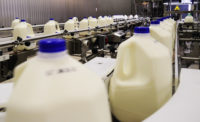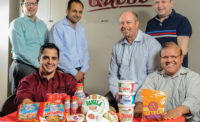
Eye on California
Compiled by Shonda Talerico Dudlicek
Contributing Editor
Contributing Editor
The Golden State continues to grow as a dairy powerhouse.
California is home to many
of the country’s leading dairy processors, including our 2007
Processor of the Year. Some are California born and bred, while others are
out-of-state companies with manufacturing facilities in the Golden State.
We invited two of California’s dairy industry
leaders — Stan Andre, chief executive officer of the Sacramento-based
California Milk Advisory Board, and Joseph O’Donnell, executive
director of the California Dairy Research Foundation in Davis — to
provide a snapshot of the state’s dairy scene. Their responses are
offered jointly.
Q: Explain how the California dairy industry has
evolved.
California has a long and rich dairy heritage. The
state’s dairy industry, like its wine industry, reaches back more
than 200 years to the Spanish explorers and missionaries who came to the
region in the 1700s. They brought both grapevines and cattle. A simple
cheese made in the early missions evolved into a farmstead cheese in the
1800s, and by the end of the century it was commercialized as Monterey
jack, the most popular cheese created here in America.
Today, California’s dairy industry is the
largest in the nation. Total milk production has increased every year since
1985 and reached 38.8 billion pounds in 2006. California has been the
nation’s leading milk producer since 1993 when it passed Wisconsin.
The state also is number one in the United States in the production of
butter, ice cream, nonfat dry milk and whey protein concentrate. California
cheese production has nearly doubled in the past decade, growing from 1.17
billion pounds in 1997 to 2.2 billion pounds in 2006. The state is
projected to move into the leadership position in cheese production in the
near future.
California is the country’s leading agriculture
state and dairy farming is the largest agricultural commodity group among
the 250 in California, producing $6.1 billion in annual sales. In 2004, the
state’s dairy industry had an economic impact on California of $47.4
billion in wages, revenues and related expenditures and generated 434,000
jobs. Today, 40 percent of California milk is sold out of state, mainly as
cheese and other manufactured products.
California enjoys the nation’s most dynamic and
diverse cheese industry. On one hand, California has the single largest
cheese plant in the world and several others that rank among the largest in
the country. We also are the country’s leading producer of
mozzarella. On the other hand, we enjoy a healthy and growing
specialty-cheese industry, including a number of nationally and
internationally acclaimed specialty, artisan and farmstead producers.
Today, the state has more than 50 cheesemakers producing 250 different
varieties and styles of cheese.
Q: What is the state’s reputation in the
industry and with the public?
California’s dairy industry has developed an
enviable reputation not only because of the quantity of milk and dairy
products it produces, but also because of their high quality. California
dairy farmers operate state-of-the-art dairies and follow industry best
practices in terms of herd care and health, which is why California dairy
cows are consistently among the most productive in the nation.
One advantage that California dairy products offer
consumers is freshness. Dairies and processors are located near each other,
and most dairy products are produced with milk that is less than 24 hours
old. The short farm-to-market time gives California dairy products an
appealing fresh milk quality.
Our cheese industry has quickly risen to the level of
acclaim given our state’s wine industry. In recent years, California
cow’s milk cheeses have been among the most-awarded American cheeses
at the World Cheese Awards held in London, one of the most respected
international cheese judgings. California cheesemakers have taken top
honors in a number of categories, including several traditionally won by
European cheeses, such as brie and cheddar. California cheesemakers also
have taken top awards year after year in the prestigious American Cheese
Society (ACS) competition. Last year, California cow’s milk
cheesemakers won 31 awards in the ACS judging.
Growing recognition of California’s cheese
industry is having a halo effect on its other dairy products. California
cheese is now available in every state and this success has opened up
national distribution channels for California butter, ice cream and other
products.
Q: Explain some of the trends California processors
are either setting or following.
California is well-known as an incubator of innovation
in many areas and this holds true for its dairy industry. California dairy
farmers are rigorously committed to best practices and, in this effort,
they are supported by scientists and technical experts at the University of
California, Davis (UC Davis) and California Polytechnic State University
(Cal Poly).
California is committed to produce the best
value-added dairy products available to consumers. We have devoted
considerable attention to our cheese industry over the past decade. As a
result, California increased the number of varieties and styles of cheese
it produces from 70 in 1995 to more than 250 today, most of them specialty
cheeses, including artisan and farmstead. We encourage and assist our
cheesemakers to develop and produce new cheeses and expect to see the range
of cheeses we offer continue to grow in the next several years.
Consumers also can feel good about purchasing
California dairy products because the state has the greenest dairy industry
in the nation. This has come about because the California dairy industry,
in meeting the highest air and water standards in the nation, has applied
state-of-the art environmental practices.
Q: What innovations have come out of the California
dairy industry?
California’s dairy industry has a long tradition
of innovation. One of the first commercial dairies in the U.S. was created
here in 1857, and in 1880 the state created what is thought to be the first
branded dairy product when a dairy located outside San Francisco
trademarked its butter.
Today, California is a leading dairy innovator. We
have a tremendous resource in the scientific research and technical
expertise at UC Davis and Cal Poly, and the work they have done, and
continue to do, greatly benefit our industry.
As a result of this research, California has
introduced new product lines such as customized nonfat dry milk powders for
the overseas markets and the large-scale production of aged Cheddar cheese,
where we have become a major supplier. Research has helped develop the
Hispanic cheese category in California and the state is the largest
Hispanic-style cheese producer in the U.S. The state was behind the
development of the now booming specialty and artisan cheese industry in the
United States.
Additionally, California researchers initiated the
discovery of whey protein as a food protectant and the use of
microencapsulation technology to deliver non-stable food additives.
California dairy research also resulted in the development of a process for
separating and purifying proteins from whey to be used as pure, natural
food stabilizers in frozen dairy desserts and other products requiring
stabilization; determined that milk protein concentrate (MPC) could be used
to standardize milk for pizza cheesemaking, opening new markets for MPC;
and ongoing work to create a set of precise, quantitative sensory languages
for the flavors in milk powders, butter and whey is providing important
information to manufacturers to remain competitive.
Export markets are growing rapidly and California
dairy manufacturers, working with our research centers, have moved to
expand dry milk product lines to meet the specifications of these overseas
buyers. Consumer interest in heath, especially through functional foods, is
a hot topic now. An example of a current trend is the area of foods
fortified with probiotics, which is experiencing a surge of new product
introductions.
Knowing that every component in milk holds some
mission in delivering nutrition and health has spurred our researchers to
fully understand the nutritional value of milk and milk components. As a
founding member of the International Milk Genomics Consortium (www.imgconsortium.org),
California is at the forefront of research tapping the tools of genomics to
discover how these milk components deliver health benefits. This, in turn,
will help in the development of new products.
Q: What is the outlook for future growth in the
California dairy industry?
California’s dairy industry has enjoyed a
historical milk production growth rate of 2 to 4 percent annually and this
is expected to continue. From 1980 to 2004, California doubled its share of
U.S. dairy supply from 11 to 21 percent. California cheese production has
also shown consistent growth, reaching 2.2 billion pounds in 2006. Nearly
half of all California milk goes to the state’s cheesemakers.
We envision continued strong growth as the California
dairy and cheese industries increase distribution nationally. We also see
major export opportunities and currently are planning export initiatives
for California dairy products, especially in Mexico and the Pacific Rim.
Q: How will California be positioned in the future as
a major dairy player?
California has the country’s most
forward-looking dairy industry. The CMAB was the first commodity group in
the United States to develop a long-range strategic plan and we are now
beginning our third five-year plan. We recently reported to our industry
that we met or exceeded every objective in the first two plans.
In the early ’80s, the CMAB hired Stanford
Research Institute to help our industry plan a course for the future and
their analysis helped to create the world class dairy and cheese industries
we have today. We recently retained McKinsey & Co. to provide a fresh
look at our industry and its future, and they have come back with a
thorough analysis and recommendations that give us a clear understanding of
both the challenges and opportunities facing our industry.
California is a national dairy leader and will
continue to expand this role in the future. Today, California produces
about a fifth of the nation’s milk supply and a quarter of its cheese
supply. U.S. consumers are increasingly looking to California for high
quality dairy products, and we will continue to expand this national
effort. As noted, we also are expanding export initiatives for California
cheese, butter and ice cream.
We also have enjoyed great success in the pizza
industry, which is very important to us because California is the
country’s leading supplier of mozzarella cheese. We now distribute
and promote our California cheese products to major pizza distributors and
restaurants nationwide.
Shonda Talerico Dudlicek is a freelance journalist and
a former managing editor of Dairy Field.

